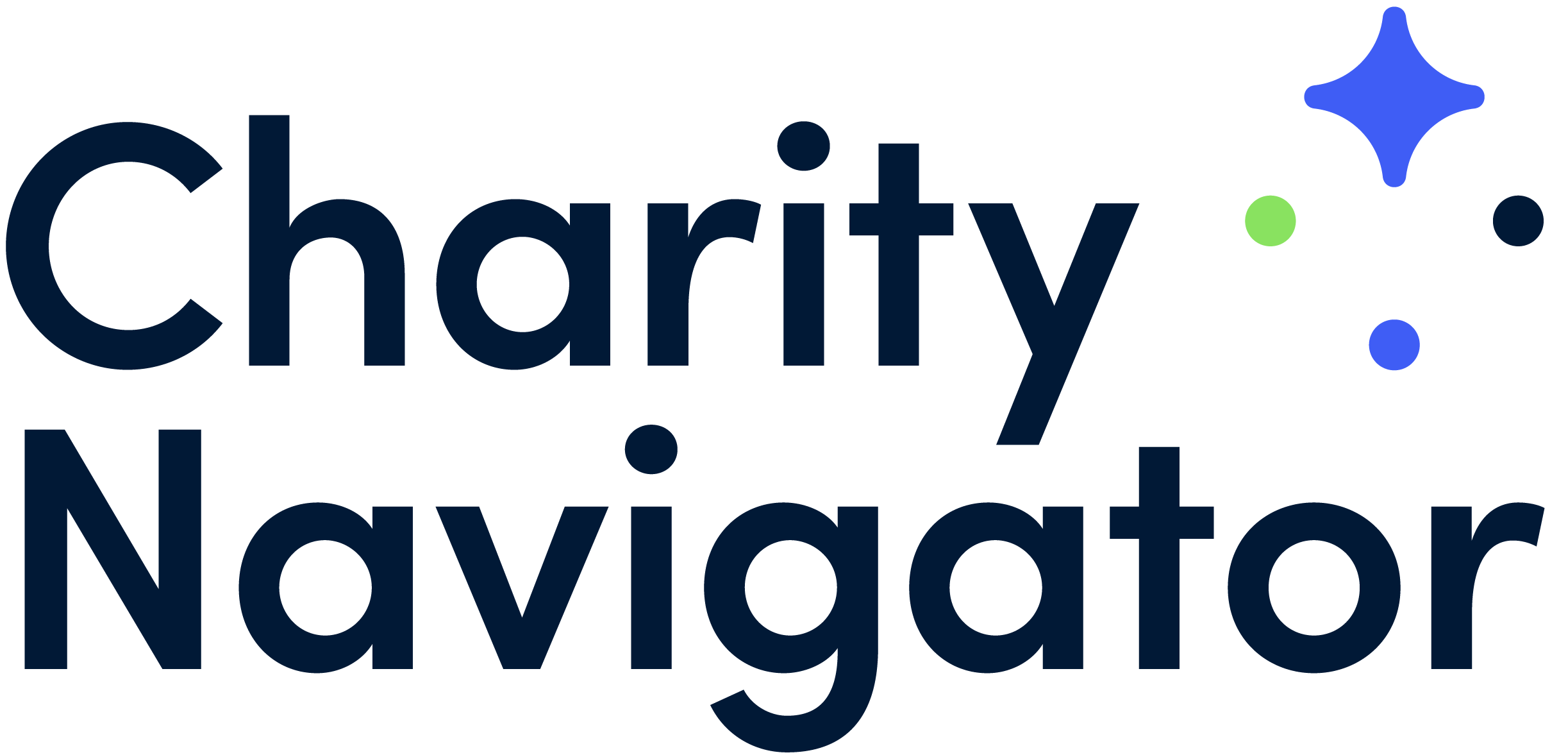
Accountability & Finance
We analyze organizations' governance practices and financial health to help donors find transparent, efficient, and sustainable charities.
This beacon equips donors with information on how charities operate and how they are stewarding the donations they receive.
How We Assess Charities' Transparency and Financial Responsibility
Throughout the year, we receive the annual tax filings (Forms 990) that charities submit to the IRS. We leverage several fields in the IRS Form 990 to generate scores for charities' Accountability & Finance beacons. Charities need at least three consecutive years of data to receive a score.
Depending on the organization's size and whether it is funded primarily by donations, some additional metrics are applicable. Explore the list below to learn more about each metric and its applicability.
Accountability Metrics
Audited financial statements provide important information about a charity’s financial accountability and accuracy. An independent accountant should prepare them. In cases where an audit is not feasible, organizations should have their independent accountant complete a financial review or compilation.
We expect charities with over $1 million in total revenue to complete an audit. For those with revenue between $500k and $1 million, we expect them to have an audit or a review or compilation. For those with less than $500k in revenue, this metric is not applicable.
For larger organizations, we also expect them to have an audit oversight committee that is responsible for choosing the independent accountant and responsible for overseeing the needed financial documentation.
Industry professionals strongly recommend an independent governing body to allow for full deliberation and diversity of thinking on governance and other organizational matters.
For most organizations, we check to see if the organization has at least three board members and that more than 50% of those members are identified as independent on Form 990.
For large, donor-funded organizations, we check to see if the organization has at least five independent board members and those members make up a voting majority.
A diversion of assets — any unauthorized conversion or use of the organization's assets other than for the organization's authorized purposes, including but not limited to embezzlement or theft — can seriously call into question a charity's financial integrity. We review the charity's most recent Forms 990 to see if the charity has reported any diversion of assets.
An official record of events during a board meeting ensures that a contemporaneous document exists for future reference. Charities are not required to make their board meeting minutes available to the public. As such, we are not able to review and critique their minutes. For this metric, we check if the organization reports on its Form 990 that it retains those minutes.
This policy outlines procedures for handling employee complaints and provides a confidential way for employees to report any financial mismanagement. Here we check if the charity indicated the existence of a policy on its Form 990.
This policy protects the organization and by extension, those it serves, when it is considering entering into a transaction that may benefit the private interest of an officer or director of the organization. Charities are not required to share their conflict of interest policies with the public. We check if the charity reports this policy on its Form 990.
This policy establishes guidelines for the handling, backing up, archiving, and destruction of documents. These guidelines foster good record-keeping procedures that promote data integrity. Here, we report that the charity indicates the existence of this policy on its Form 990.
Nonprofits should have an online presence so that the public can easily find information about their programs, activities, and leadership.
Applies to donor-funded charities with $2 million or more in annual revenue.
Making loans to related parties, such as key officers, staff, or Board members, is not standard practice in the sector as it diverts the charity's funds away from its charitable mission and can lead to real and perceived conflict-of-interest problems.
The IRS requires charities to disclose on their Form 990 any loans to or from current and former officers, directors, trustees, key employees, and other "disqualified persons." Some state laws go so far as to prohibit loans to board members and officers.
Although employees and trustees are permitted to make loans to charities, this practice can also result in real and/or perceived conflict of interest problems for the charity. Furthermore, it is problematic because it indicates that the organization is not financially secure. Our analysts check to see if any loans have been made.
Applies to donor-funded charities with $2 million or more in annual revenue.
Providing copies of the Form 990 to the governing body prior to filing is considered a best practice, as it allows for thorough review by the individuals charged with overseeing the organization. The Form 990 asks the charity to disclose whether or not it has followed this best practice.
Applies to donor-funded charities with $50 million or more in annual revenue.
Donors can be reluctant to contribute to a charity when their name, address, or other basic information may become part of donor lists that are exchanged or sold, resulting in an influx of charitable solicitations from other organizations. Our analysts check the charity's website to see if the organization has a donor privacy policy and if its contents are sufficient to protect the donor’s information.
Applies to donor-funded charities with $50 million or more in annual revenue.
Our analysts check to see if the charity lists its board members on its website. Publishing this information enables donors and other stakeholders to view the makeup of the charity's governing body. While the board members should be reported on the Form 990, the members may have changed since then. The charity’s website will typically reflect the most current list of members.
Applies to donor-funded charities with $50 million or more in annual revenue.
Donors and other stakeholders need to know who runs the organization. While key staff should be reported on the Form 990, the charity's staff may have changed since then. The website shows the most current team members.
Applies to donor-funded charities with $50 million or more in annual revenue.
Charity Navigator checks the charity's website to see if it has published its most recent financial statements. We check if an organization publishes its audit on its website.
Applies to donor-funded charities with more than $50 million in annual revenue.
This process indicates that the organization has a documented policy that it follows each year. The policy should indicate that an objective and independent review process of the CEO's compensation has been conducted, including benchmarking against comparable organizations. We check to ensure that the charity has reported its process for determining the CEO's pay on its Form 990.
Applies to all donor-funded charities with more than $50 million in annual revenue.
Charities must list their CEO's name and compensation on the Form 990. Our analysts check to be sure that the charities complied with the Form 990 instructions and included this information.
Applies to donor-funded charities with more than $50 million in annual revenue.
All board members must be listed on the form 990 with an indication of whether or not they are compensated. Our analysts verify that the charities complied with the Form 990 instructions and that no board members are compensated simply for being on the board.
Financial Metrics
Charities exist to provide programs and services. They fulfill donor's expectations when they allocate a good portion of their budget toward their stated missions. While administration expenses are necessary for efficient charity operations, organizations that grossly underspend on their programs and services will likely not have as strong an impact on their charitable missions.
We calculate the nonprofit's average program expense percentage over its three most recent fiscal years and then assign a numeric score based on an established scale.
Part of our goal in rating the financial performance of charities is to help donors assess a charity's financial capacity and sustainability. As do organizations in other sectors, charities must manage their total liabilities in relation to their total assets. This ratio is an indicator of an organization's solvency and or long-term sustainability. It can signal potential issues within an organization, and additionally, it displays how well the charity is managing this balance compared to organizations in the same cause area.
This metric helps donors understand if their donations may be used to service debt and/or other obligations rather than servicing the charitable mission.
We calculate a charity's ratio of liabilities to assets by comparing the organization's total liabilities to total assets in the most recent tax year analyzed. Then we assign a numeric score based on an established scale.
Applies to donor-funded charities with more than $2 million in annual revenue.
Charities depend upon their reserves of liquid assets to survive downward economic trends and sustain their existing programs and services. If a charity has insufficient working capital, it faces the difficult choice of eliminating programs or staff, amassing debts and liabilities, or dissolving. In contrast, when giving flows, those charities that build working capital develop a greater capability for expanding and improving their programs. We analyze a charity's working capital ratio by determining how long it could sustain its current programs without generating new revenue. We calculate the charity's working capital for the rated year and its average total expenses over its three most recent fiscal years. We then calculate the ratio between working capital and average total expenses and then assign a numeric score based on an established scale.
Find Accountable Charities
Discover charities rated on Accountability & Finance. Find a new and exciting giving opportunity.


